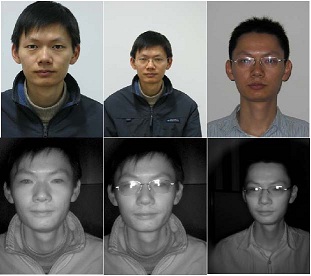|
After published in 2009, the HFB database has been applied
by tens of research groups and widely used for Near
infrared vs. Visible light (NIR-VIS) face recognition. Despite
its success the HFB database has two disadvantages:
a limited number of subjects and lacking specific evaluation
protocols.
To complement the disadvantages of the HFB database,
we collect a larger database called CASIA NIR-VIS 2.0
database, in which the images are captured using the same
device as the HFB database. Compared to HFB, NIR-VIS
2.0 has the following new features:
- The number of subjects in the NIR-VIS 2.0 database is
725, which is 3 times more than the HFB database.
- We define a group of specific protocols for performance
evaluation. On the contrary, the protocols of the
HFB database are unclear for performance comparison
or for reproducing experimental results.
- In the new database, the age distribution of the subjects
are broader, spanning from children to old people.
- The face images are collected in four recording sessions,
which are from 2007 to 2010.
The images in the NIR-VIS 2.0 database were collected
in four recording sessions: 2007 spring, 2009 summer, 2009
fall and 2010 summer, in which the first session is identical
to the HFB database. In summary, the NIR-VIS 2.0
database consists of 725 subjects in total. There are 1-22
VIS and 5-50 NIR face images per subject. Figure 1 shows
some face images of a subject in the database.

Figure 1. VIS and NIR face images, with variations in resolution,
lighting conditions, pose and age, of one subject in the NIR-VIS
2.0 database.
The NIR-VIS 2.0 database
includes the following contents:
- The raw images, including the VIS images in JPEG
format and the NIR images in BMP format. Their resolutions
are both 640X480.
- The eye coordinates of the VIS, NIR images. They
are automatically labeled by an eye detector, and
several error coordinates are corrected manually.
- Cropped versions of the raw VIS, NIR images. The
resolution is 128X128, and the process is done based
on the eye coordinates.
- Protocols for performance evaluation. The protocols
include two views: View1 for algorithm development,View2 for performance reporting.
Results:
Accuracy and ROC curves for various methods available on results page.
Download Instructions:
To apply for the database, please follow the steps
below:
- Download and print the document Agreement
for using CASIA NIR-VIS 2.0 database
- Sign the agreement
- Send the agreement to cbsr-request@authenmetric.com
- Check your email to find a login account
and a password of our website after one day, if your
application has been approved.
- Download the CASIA NIR-VIS 2.0 Face database
from our website with the authorized account within 48
hours.
Copyright Note and Contacts:
The database is released for
research and educational purposes. We hold no liability for
any undesirable consequences of using the database. All rights
of the CASIA NIR-VIS 2.0 database are reserved. Any person or
organization is not permitted to distribute, publish, copy,
or disseminate this database.
Publications:
[1] Stan Z. Li, Dong Yi, Zhen Lei, Shengcai
Liao, “The CASIA NIR-VIS 2.0 Face Database”. In 9th IEEE Workshop on Perception Beyond the Visible Spectrum (PBVS, in
conjunction with CVPR 2013). Portland, Oregon, June,
2013. |

